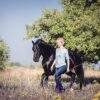When everyone is calm the communication can start.
When you are scared of your horse and your horse is afraid of you communication is simply impossible. Everyone is following their habitual instincts and nothing new can emerge. Calmness is very easy and very difficult at the same time. You need to feel safe with your horse and vice versa. This is really our first objective, that everyone will feel safe.
- In theory, this means that the feeling of being safe is something we want to preserve during the whole training and being with our horses.
- In practice, this means that we will never do anything that could be dangerous or that could be offensive or oppressive for our horse.
- In effect, this means that we need to communicate in both ways.
Communication is talking and listening. From my experience, this is the first and very big change in attitude for people that I train – that they really need to start listening to their horse. When people hear that they will communicate with their horse, they think about commands, cues and aids. And this is correct. But we also need to develop the reverse direction of communication. Our horse also will want to train us to read his cues, aids and commands. And this will be absolutely fine. We will let ourselves be trained, too.
Our horse will start to show us when training lasts for too long, when an exercise is too boring or too difficult to him. He will show us when something is uncomfortable to him because he feels pain or finds the new criteria too difficult to try. He will also tell us when he likes something very much, and when he wants to do something else.
And we really need to be open for this and we really need to react to this communication.
Communication is never ONE-WAY, it’s always TWO-WAY.
And now it is very clear why we need calmness. If the horse is afraid of us, or is afraid of the situation he was put in, he will try to tell us only one thing: “I’m afraid, I want out of here”. And any further communication will be impossible.
Communication is very important to preserve calmness during later training and any advanced exercises. You will need a way to ask your horse to do something, to explain to your horse that we will do something new now. And your horse needs to feel safe with you that whenever he tells you “it’s too much for me” or “it’s too boring for me” or “I feel uncomfortable now” you will act on this. And both parties will respect each other.
This way you will also feel safe because you will know that your horse will not do anything out of the blue, he will not surprise you with his behaviours and acts. He will always tell you before that the situation is starting to be overwhelming for him.
In practice, communication is very simple to achieve.
First of all, you have to be open, and very aware of your inner self. Being aware of your inner self will allow you to be aware of your horse’s feelings and of the things he is trying to tell you. It will allow you to be aware of your horse’s inner self.
Being aware of your inner self will allow you to be very readable for your horse. Because you will be connected with the real you and you will not have to think about how you feel and what to do. You will know what to do before any thinking process starts. This is because you will act from the level of the inner self. Your actions will come from the Nature and the Field of Life.
In practice, being readable means that you will do very little when you are with your horse to give him a chance to learn your body language and your cues. And again, to do very little you need to be very calm. You have to BE. And to BE means to know your inner self.
And to act from that level.


